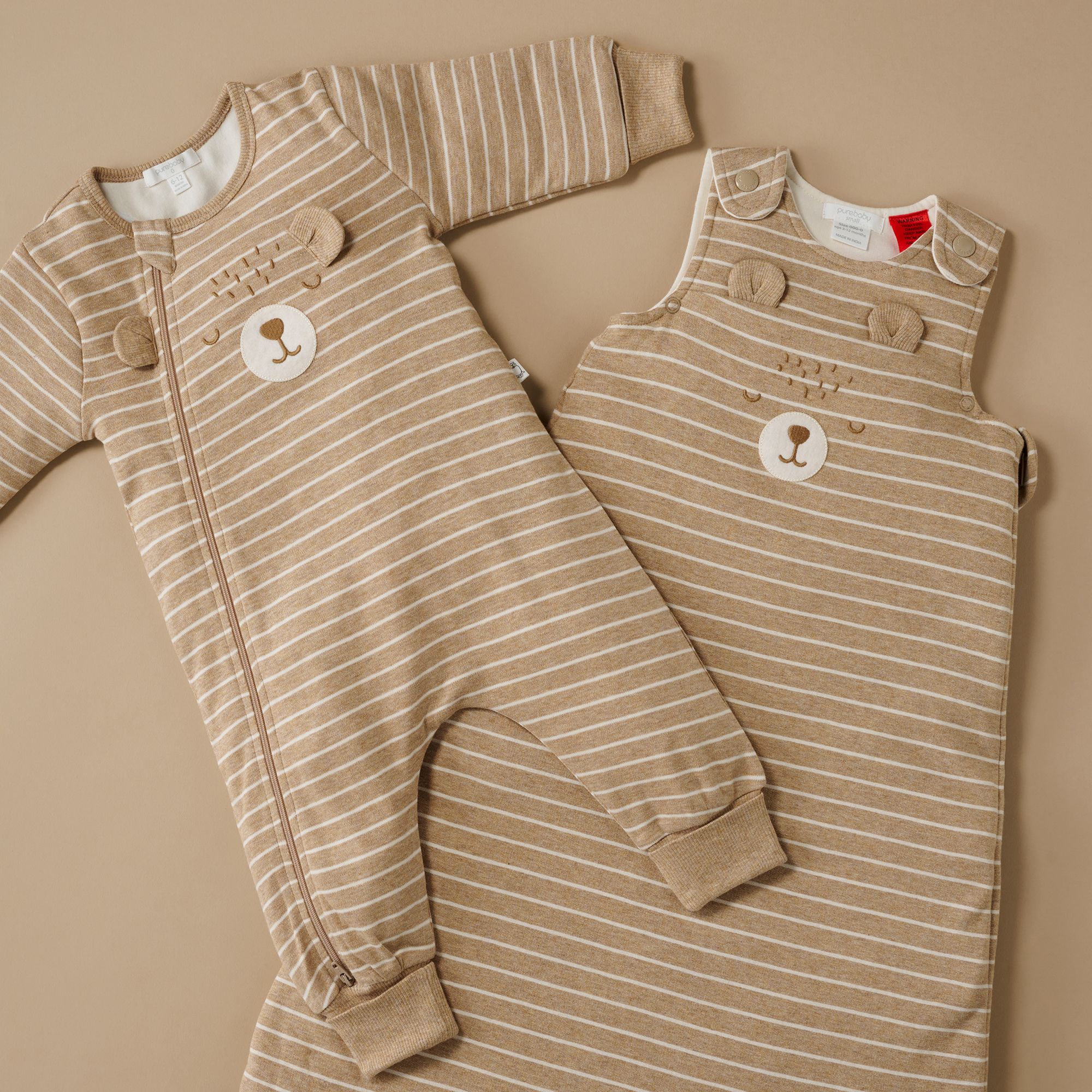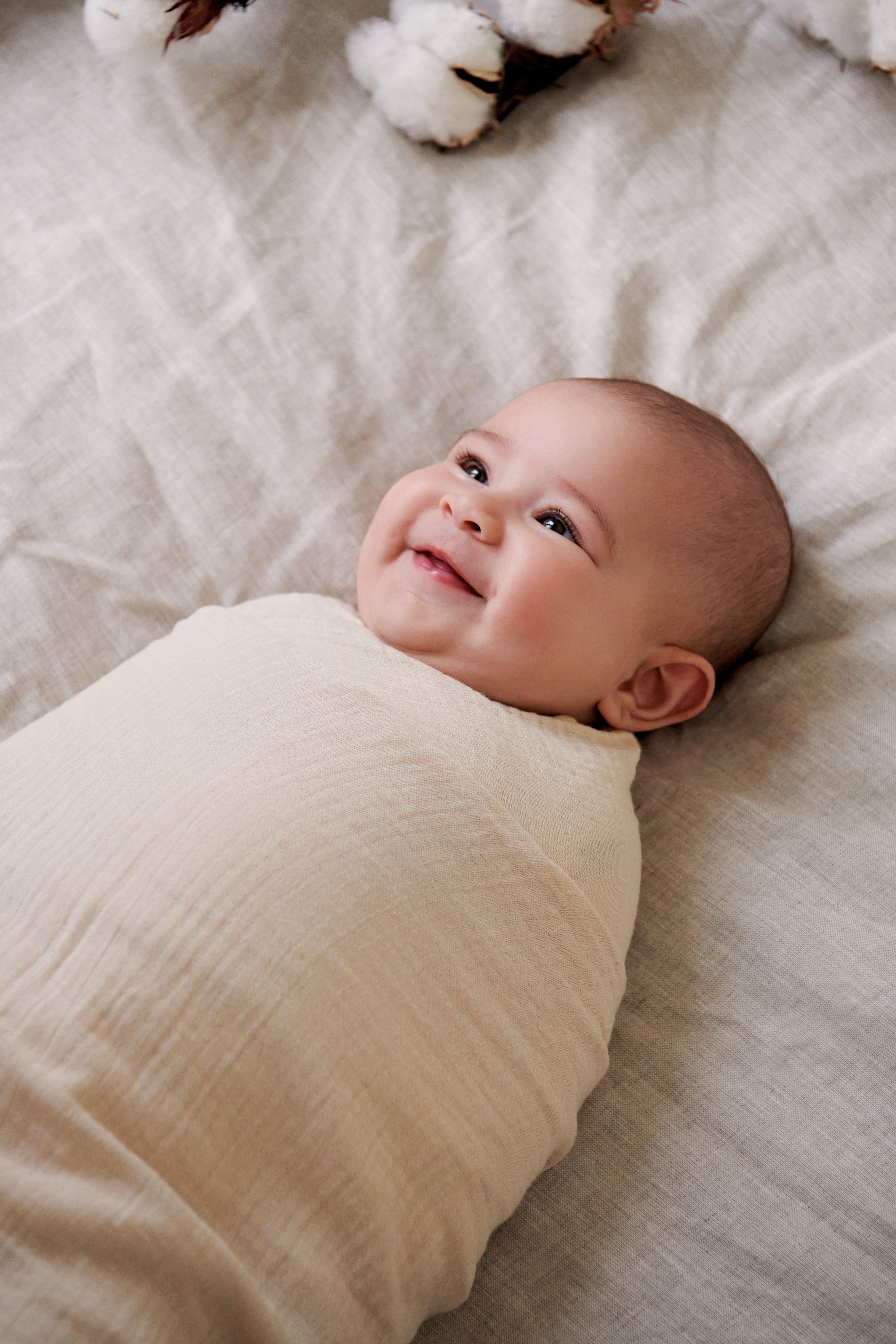
How To Fold Baby Clothes
8 min read | 18 March 2024
10 min read | 01 April 2024

A common question asked by new parents is "how should I dress baby for sleep?". Aside from being unable to communicate whether they're hot or cold, newborn babies are not able to regulate their body temperature as effectively as adults, which makes knowing how to dress them at bedtime a little tricky.
It's important that babies are dressed appropriately for sleep. For safe infant sleep, babies should be comfortably warm when going to bed - not too hot or too cold.
In this blog post, we'll look at some guidelines and safety tips to ensure your little one is both safe and comfortable when going to sleep.

Here are a few things to consider to help create a safe sleep environment for your little one:
The clothing you dress your little one in for bed will depend on the season and the temperature of the room. Opt for fitted, breathable baby wear made from natural fibres that can removed or added as the temperature changes.
Rather than checking your baby's fingers and toes to see how warm or cool they are, feel their back or tummy to get a better indication of their temperature. You can also check their temperature by placing a thermometer under their arm.
Red Nose, Australia's leading authority on safe sleep, does not recommend a specific room temperature for baby sleep. The organisation recommends adjusting your baby's clothing for different temperatures rather than heating or cooling the room.
Wrapping young babies in a swaddle can help settle them for sleep and keep them in a safe sleeping position on their backs. A swaddle also provides an extra layer of warmth over sleepwear.
Once babies start showing signs of rolling, they should no longer be swaddled. At this point, you may wish to switch to a safe baby sleeping bag - a wearable blanket designed to provide your little one with an extra layer of warmth without having to use blankets.

Babies' beds really only need a fitted sheet and a lightweight blanket or sleeping bag. If you're using a blanket, make up the bed so that the baby is sleeping at the bottom of the cot and the blankets only reach as far as the baby's chest. It's important to make sure that your baby can't wriggle down the bed and get their head covered by the blanket.
Other soft items and loose bedding like doonas, pillows, cot bumpers, soft toys and lambswool can be dangerous, as they can cover a baby's head and face and obstruct breathing or cause overheating.
A good rule of thumb when getting your baby ready for bed is to dress them as you'd dress yourself for the temperature of the room. They should be comfortably warm, not too hot and not too cold.
In warm weather, your baby will most likely be comfortable in their nappy and a singlet, or a sleeveless or short-sleeve bodysuit, as well as a light swaddle or sleep sack.
Cooler weather calls for more layers to keep your baby warm. Depending on the temperature of the room, your baby might be most comfortable in a full-length cotton onesie with a slightly thicker wrap or sleeping bag. Add a singlet or bodysuit underneath if the weather is really chilly.
Baby wrapping or swaddling from birth can help settle your little one for sleep, and can also help them to stay safely on their backs when sleeping in their cot or bassinet.
There are many different ways to swaddle, but the most important thing to remember is to keep your baby's head, ears and chin uncovered so as not to obstruct baby's breathing and cause overheating.
When wrapping your baby, use swaddles or a light blanket made from natural, breathable fabrics like lightweight cotton or muslin, and dress them in layers underneath to avoid overheating.
Once your baby starts rolling onto their tummy, it's time to remove the swaddle and consider using a sleeping bag or blankets for sleep.
or sleep sacks are wearable blankets with armholes or sleeves that keeps your baby comfortable in bed.
A safe and correctly sized baby sleep sack is safe to use, as it can help keep your little one's head and face uncovered which can reduce the risk of sudden unexpected death in infants
A sleep sack can also keep your little one's legs contained and prevent them from hanging through the cot rails.
When selecting a sleeping bag for your baby, choose one with a fitted neck and armholes but no hood - it should be impossible for your baby to slip down inside the sleeping bag.
Some sleeping bags have a TOG (thermal overall grade) rating which can help you select the right weight of bag for the temperature. These sleeping bags often come with guidelines as to how to dress your baby underneath the sleeping bag - however this is just a guide.
Red Nose does not recommend a specific room temperature for healthy babies, and instead suggests that dressing your baby appropriately for the temperature of the room, placing them down to sleep on their back and keeping their head and face uncovered is the best way to ensure they're comfortable and prevent them from overheating.
When dressing your baby for sleep, there are a few things you should steer clear of to help make sure they're comfortable and reduce the risk of their environment being unsafe:
Hats, beanies and head coverings: these may cover your baby's face in their sleep, leading to breathing obstruction and/or overheating.
Doonas, pillows, bumpers, lambswool and cushions, as well as soft items like stuffed animals: while these may seem to make your little one's sleeping space cosy and comfortable, they also have the potential to cover their faces and cause overheating.
Electric blankets and hot water bottles: these have the potential to cause overheating and burns.
Dress your baby in natural, lightweight fabrics. We love organic cotton, which is breathable and washes and dries beautifully.
For newborns and young babies,
fitted onesies
are both safe and comfortable. Choose styles with 2-way zips for easy night time nappy changes.
For toddlers, two-piece
pyjama sets
made from organic cotton are both cute and practical, as they can be mixed and matched and allow for easy nappy changes and trips to the toilet.
Stock up on layering pieces like
singlets and bodysuits
with both short and long sleeves to pop under onesies and pyjamas on cold nights.
Look for
sleeping bags with a TOG rating
, and chose the right one based on the temperature of your room or the climate where you live. It can be helpful to have a couple of different sleeping bags with different TOG ratings so that you can.
Discover Purebaby's range of sleepwear and sleeping bags in-store or online at Purebaby.com.au
Sign up to Pure Love Rewards and get $10 off your first online order, earn points every time you shop and more!